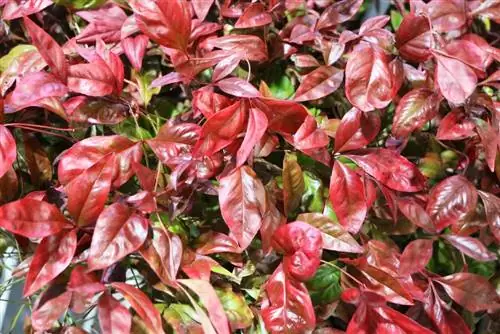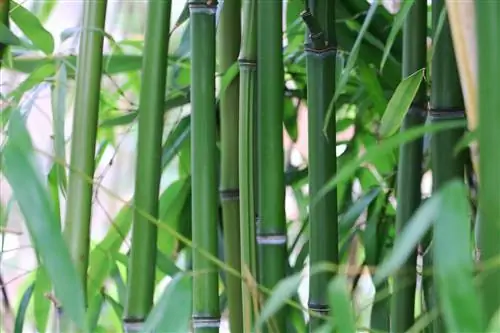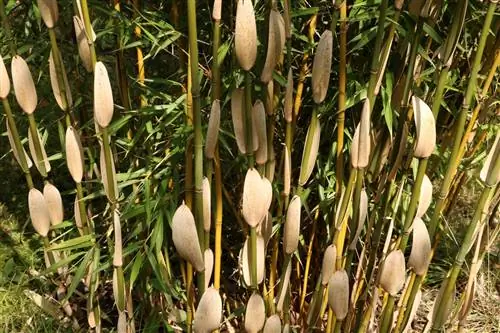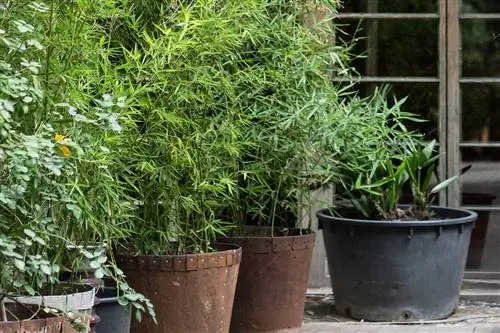- Author admin [email protected].
- Public 2023-12-17 03:39.
- Last modified 2025-01-24 12:45.
The sky bamboo is a shrub that grows up to 3 meters high and originally comes from China, India and Japan. The botanical name is Nandina domestica, the evergreen sky bamboo belongs to the barberry family and is not related to conventional bamboo. The shrub is only partially hardy and can be cultivated in a protected location in the garden and as a houseplant. You can choose from both monochrome varieties and variants with reddish or white-green patterned leaves.
Location & plant substrate
The sky bamboo needs a bright location, but cannot tolerate the intense midday heat. However, if the bush is in a place that is permanently too dark, it will not feel comfortable and the flowers and the resulting berries will diminish significantly. The following aspects must be taken into account when it comes to the location and plant substrate:
- suitable as a solitary plant or in group planting
- prefers partially shaded and wind-protected location
- Morning or evening sun in summer is ideal
- from autumn to spring, direct midday sun is also tolerated
- suits thematically for the design of Japanese temple gardens
- optimal for keeping in large planters and pots
- needs moist garden soil with loamy and humus content
- Flower or pot plant soil is suitable as a plant substrate
- loose up with a little sand and clay granules, improves permeability
Watering & Fertilizing
The sky bamboo doesn't like it too wet or too dry; constant watering is important, increased in summer and significantly less in winter. Fertilizing should only be used during the growing season; fertilizer applications should be paused in the winter. The following criteria are crucial when watering and fertilizing:
- water regularly, especially in the summertime
- Let the root ball be completely soaked with water
- only water when the soil is dry but not completely dry
- Waterlogging and dryness of the root ball are not tolerated in the long term
- Use low-lime water, stale rainwater is ideal
- fertilize from spring to autumn, twice a month
- Liquid fertilizer or sticks are ideal
- When gardening, use fertilizer for shrubs, mineral or organic
Tip:
Whether the planting substrate for potted plants is still sufficiently moist can be quickly determined by the weight of the container. The lighter it is when lifted, the less moisture it contains.
Leaves, fruits & growth
The evergreen sky bamboo has a very individual charm and beautifies any garden, balcony, terrace or room. Because of its growth and leaves, Nandina domestica is called bamboo, but does not belong to this genus. The bright flowers, the alternately colored foliage and the colorful fruits beautify the shrub and give it an unmistakable touch:
- perennial and evergreen ornamental shrub
- Wood with tightly upright and clump-like growth, height about 1-3 meters
- multipinnate, elliptical and lanceolate leaves
- Foliage changes colors, reddish when sprouting, later turns into green leaf color
- In autumn, leaves turn a crimson color
- Flowering period from June to July
- white flowers sit together in upright panicles, length up to approx. 30 cm
- This is followed by bright red and spherical fruits
- Fruits remain on the bush well into winter
- good for obtaining decorative cut greens, with fruit decoration, suitable
- can be grown as a bonsai
Tip:
The flowers can tilt downwards and break off due to their own weight. In this case, a supporting stick to which the flower spike is tied will prevent it from snapping.
Repotting
If root growth and external shoots become excessive, repotting should be carried out so that the Nandina domestica can develop without obstacles:
- protruding and compacted roots are indications for repotting
- choose a sufficiently large planter
- Carefully remove the root ball from the old bucket and move it
- fill new pot with loosened plant substrate
- Do not fertilize additionally in the first year after repotting
- then administer liquid or slow-release fertilizer in the second year from spring to autumn
Cutting
The Nandina domestica only needs to be pruned if space is limited; this is often the case quickly, especially when kept in containers. For a dense, bushy growth with many branches, the selected shoots should be allowed to grow to the intended height, then the tip is pulled out mechanically. The following procedure has proven successful when pruning:
- Thin the shrub regularly, moderate pruning is possible all year round.
- When pruning in spring, also remove the flowering shoots.
- The best time for a radical cut is autumn.
Wintering
The sky bamboo is only partially hardy; the plant cannot tolerate low temperatures in the long term. It only thrives all year round in gardens located in regions with reasonably mild winter temperatures. Otherwise he has to move to suitable winter quarters. When temperatures are consistently cold below zero degrees Celsius, the leaves often fall off and thinner shoots freeze. The Nandina domestica is made winter-proof with sufficient winter protection. The following aspects should be taken into account when wintering:
- needs mild temperatures in winter
- Although frost hardy down to -10 °C, but only for a short time
- Winter protection is necessary in the first years of life and at low temperatures
- Cover soil with mulch, bamboo mats or brushwood
- Wintering in a cold house is ideal
- continue to water in winter, but only water moderately
- Place potted plants in bright and cool winter quarters, at approx. 5-10 °C
- becomes susceptible to diseases and pests when near radiators
Propagate
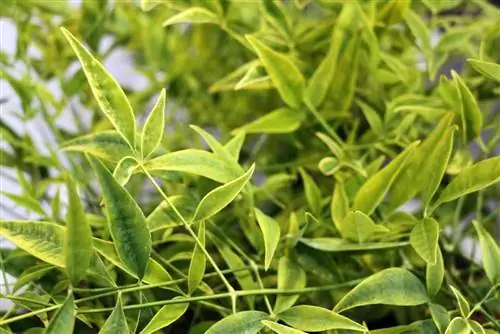
Nandina domestica is relatively easy to propagate in a variety of ways, with dividing the roots being the easiest method. In some cases, propagation with seeds is difficult and also lengthy. The following criteria are important for propagation:
- Carefully separate the root shoots and replant them
- Take cuttings and let them root in a glass of water
- Growing with cuttings can be carried out all year round
- cut off half-woody branches in summer
- ideal temperature values for rooting are over 20 °C
- carry out at room temperature in winter
- Growing from seeds possible, irregular germination time, approx. 1-6 months
Diseases & Pests
The sky bamboo is a very robust and resilient plant, but diseases and pests can quickly appear if care is taken incorrectly and the location conditions are incorrect:
- susceptible to scale insects and spider mites in heated rooms
- Waterlogging leads to root rot
Conclusion
The sky bamboo is an attractive ornamental shrub that is reminiscent of bamboo, but is not. It enchants the viewer in autumn with its colorful leaves and fruits and sets colorful accents in the otherwise dull garden. However, the Nandina domestica can only survive a mild winter outside, otherwise the plant needs suitable winter quarters. With appropriate care and correct location conditions, the garden shrub reaches considerable heights and sizes and needs appropriate space.
What you should know about the sky bamboo in brief
- The sacred bamboo is also called temple bamboo or heavenly bamboo. However, it is not bamboo at all. The plant belongs to the barberries.
- Sacred bamboo is a loosely upright growing evergreen shrub. Its leaves turn slightly reddish over the winter.
- Of course it attracts attention in the garden during the rather dreary season.
- The bamboo, which isn't even a bamboo, can grow up to 2 meters high. It originally comes from central China and Japan.
- Nandina domestica is suitable as a single or group plant and particularly for theme gardens (Japanese gardens).
- The sacred bamboo also works well as a bonsai. The flowers appear in panicles in June/July. They are white, upright candles up to 30 cm long.
- The flowers often lean downwards due to their own weight. Small red berries later develop that remain on the bush even in winter.
Location
- It is important not to expose the sacred bamboo to too much sun. He doesn't like the midday sun that much.
- It should be planted in partial shade, but still have light.
- If you plant it too dark, the flowering will slow down and fewer berries will appear. It is also sensitive to wind.
- If the humidity is high, the sacred bamboo can also tolerate sun.
Planting substrate
- A loamy, humus-rich garden soil is best suited. The soil should always be slightly moist.
- For potted plants, loosened potted plant soil with an addition of lava grit, expanded clay, gravel, grit or coarse sand is suitable.
Watering and fertilizing
- The irrigation water should not be too calcareous. Rainwater is ideal.
- It needs to be watered regularly. Water thoroughly and then wait a few days until the top layer of soil has dried thoroughly.
- The plant needs a lot of water in summer, much less in winter.
- The root ball must not dry out. This is especially true for plants kept in containers.
- The sacred bamboo is sensitive to dryness, but also to wetness.
- Fertilization is carried out from May to mid-August, but only sparingly.
- If you fertilize for longer, the autumn colors will no longer be as beautiful.
- Complete fertilizer is used for fertilizing every 14 days.
- Alternatively, commercially available organic or mineral fertilizers are available for early-flowering garden shrubs.
Wintering
- The Sacred Bamboo is somewhat hardy. It can tolerate frost down to -10 ˚C, but only for a short time.
- It is better to only plant it in areas with fairly mild winters.
- However, winter protection is recommended in the first few years.
- If you don't want to take any risks, it's better to overwinter the sacred bamboo in a cold house.
- If you want to plant it out, you should plant it very sheltered, especially protected from the wind.
- At temperatures below -10 ˚C, the leaves may fall off and finer shoots may freeze back.
- Watering in winter is important as the leaves evaporate water.
- It is best to overwinter Sacred Bamboo as a container plant in a bright place and at around 5 ˚C.
Cut
- It is good to thin out the plant regularly. You can do this all year round.
- If you want to cut it back properly, it's best to do it in autumn.
- When pruning in spring, remove flower shoots.
- Actually, the sacred bamboo doesn't need to be cut at all.
- So that it branches better, let the shoots grow to the desired height.
- Then you simply pull the tip out with your finger.
Propagation
- The Sacred Bamboo is easy and can be propagated in various ways.
- You simply separate root shoots or take cuttings and let them root.
- Semi-lignified branches that are cut in summer are ideal for this.
- The plant can also be propagated by seeds. These germinate best in a cold box.

